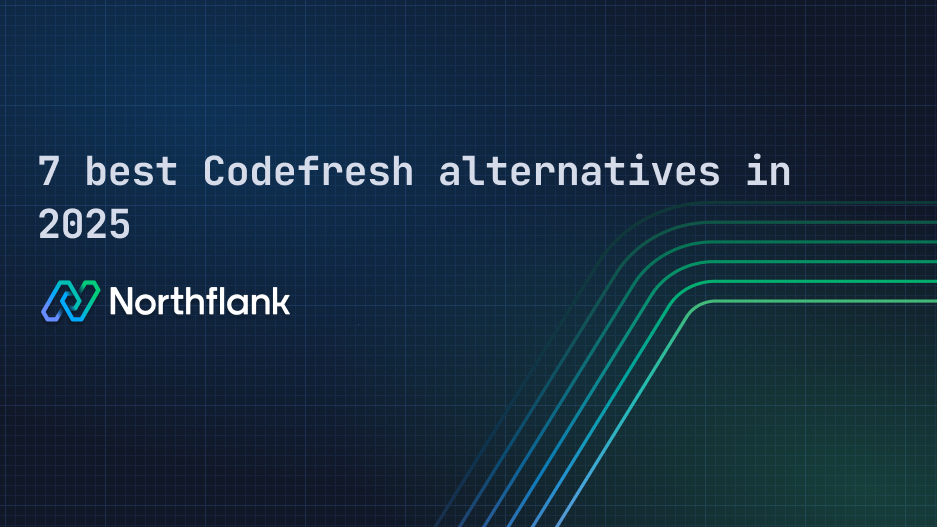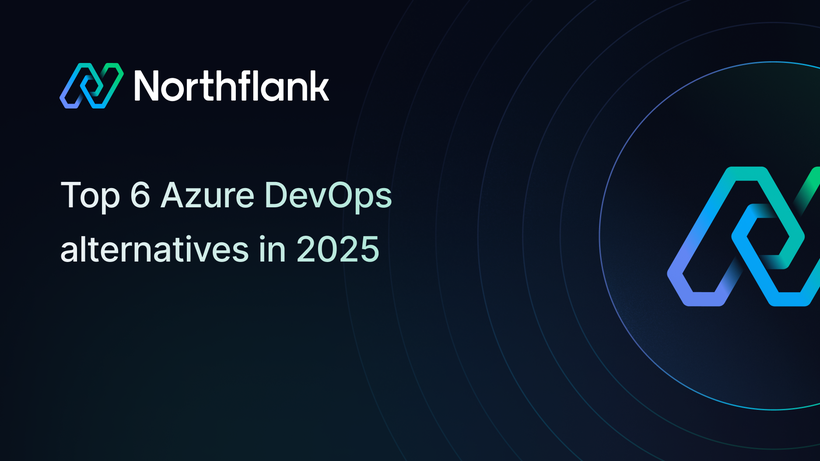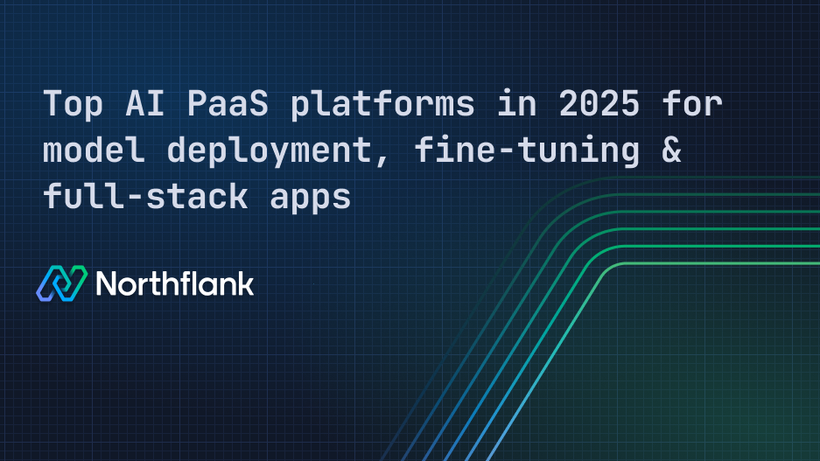

7 best Codefresh alternatives in 2025
If you’re using Codefresh, you already know it’s built on top of ArgoCD. It gives you a hosted GitOps runtime, visual dashboards, and rollout tracking for Kubernetes deployments. That setup works well for many teams, but it might not be what your team needs.
How does your team work? Do you want:
- More control over your CI/CD setup
- Fewer layers between code and deployment
- A delivery model that doesn’t rely on ArgoCD
- A platform you can self-host or run in your own cloud (BYOC)
- Or just something simpler than what Codefresh offers right now?
If any of that sounds like what you’re looking for, you’re in the right place.
This guide breaks down seven (7) Codefresh alternatives, with enough context to help you decide which one best fits your team.
Let’s get into it.
Short on time? Here’s a quick breakdown of the best Codefresh alternatives and what they’re good at:
- Northflank – Kubernetes-native CI/CD, preview environments, and Bring Your Own Cloud (BYOC) support
- Argo CD – Open-source GitOps controller that powers Codefresh's delivery engine
- GitLab CI/CD – Built-in pipelines with Git and Kubernetes integration
- Octopus Deploy – Release orchestration and deployment policies across environments
- Jenkins X – Kubernetes-native automation with GitOps-style triggers
- Harness – Enterprise-grade CI/CD with policy engines and canary support
- Spinnaker – Multi-cloud app delivery with visual pipeline management
I know you plan to choose the best option for your team and your project, but if you’re unsure what to look out for, this section should help. It'll give you a clearer picture of what you need so you don’t waste time testing the wrong platform or run into avoidable issues later.
So, let’s see a few questions you should ask before making a decision.
Codefresh gives you both pipelines to build and test your containers (CI) and tools to deploy them to Kubernetes (CD). But not every alternative does that. Some tools focus only on deployments. Others will expect you to plug in a separate CI engine like GitHub Actions, Jenkins, or GitLab CI.

If you want an all-in-one setup where builds, tests, and deployments are handled in one place, that narrows your options. If you already have CI sorted and just want a better deployment experience, you have more flexibility.
Some teams are fine running everything through CLI commands or Git-based syncs. Others need a UI to track what’s been deployed, see real-time logs, and understand what’s going on in staging or production.

Codefresh gives you dashboards, rollout history, and diffs. If that kind of visibility matters to your workflow, especially when working across environments or with non-technical stakeholders, make sure your next platform includes it. Not every tool gives you that out of the box.
Codefresh supports all of these, but again, not all alternatives do. If your workloads are packaged as Helm charts or Docker images, or you’re deploying across multiple clusters, your platform has to support those formats natively.
Some tools assume a specific deployment model (like raw manifests or Kustomize), and others might not handle multi-cluster coordination well. Be clear about what your current setup looks like and what it needs to grow.
Some platforms are only available as SaaS, meaning your workloads and deployment logic live on someone else’s infrastructure. That might be fine, but if you have security requirements and compliance rules or just prefer to run things in your own cloud, that rules out some options.

BYOC is a good middle ground; you use the platform’s UI and features, but it runs in your own AWS, GCP, or Azure account. If that’s important to your team, look for tools that explicitly support it.
Whatever platform you switch to should work cleanly with your source control and existing workflows. That means Git-based triggers, support for pull/merge requests, secret management, and access control.
If you rely on branch protections, pipeline policies, or approval workflows, make sure your next CI/CD tool can plug into those without you rebuilding everything from scratch.
If you're short on time and just need a high-level view, the table below gives you a quick comparison of platforms that can replace Codefresh. It covers whether they support CI, how they handle Kubernetes-native delivery, their deployment strategies, and where they run.
The goal here isn’t just to check boxes, it's to show what each tool focuses on, so you can match it with your own setup and workflow.
| Platform | CI support | Supported deployment features | Hosting options | Pricing |
|---|---|---|---|---|
| Northflank | Built-in CI/CD | Rolling deploys, preview envs | SaaS, BYOC | Free tier + usage-based |
| Argo CD | CD only | GitOps sync, Helm, rollback | Self-hosted | Free (open source) |
| GitLab CI/CD | GitLab pipelines | K8s agent, merge-based deployments | SaaS, Self-hosted | Free + paid plans |
| Octopus Deploy | No native CI | Helm, manual approval gates | SaaS, Self-hosted | Paid only |
| Jenkins X | Built-in CI | GitOps, preview environments | Self-hosted | Free (open source) |
| Harness | Full CI/CD | Canary, blue-green, policy checks | SaaS | Enterprise pricing |
| Spinnaker | CD only | Rolling deploys, multi-cloud delivery | Self-hosted | Free (OSS) + vendor support |
Let’s break down each platform in more detail, so you can compare their strengths, understand the trade-offs, and find the one that fits your team best.
Northflank gives you everything in one place: CI/CD pipelines, container builds, preview environments, and Kubernetes-native deployment. You can ship from Git without needing to maintain a GitOps controller, and you get visibility with visual logs, rollback history, and deployment status built in.

You can run Northflank in your own infrastructure using BYOC or use it fully hosted.
You also get:
- Integrated CI/CD pipelines with container builds and Git triggers
- Preview environments for testing changes before production
- A clean UI with deployment status, logs, and rollback history
- Run in your own cloud (BYOC) with full GUI support (no CLI setup needed)
Compared to Codefresh, it gives you a similar visual experience but removes the complexity of managing agents or relying on ArgoCD underneath.
Go with this if you want everything in one place: CI, CD, observability, and your choice of cloud.
See Scaling 30,000 deployments with 100% uptime - how Clock uses Northflank
Argo CD is the open-source GitOps engine that powers Codefresh’s deployment layer. It is a good option if your team prefers declarative infrastructure and wants full control over how applications sync from Git to Kubernetes.
It doesn’t come with built-in CI or a hosted UI like Codefresh, but it gives you fine-grained control over how you define, sync, and track deployments.

With Argo CD, you get:
- Git-based declarative sync and drift detection
- Native support for Helm, Kustomize, and manifest diffs
- Clear visibility into application state and sync status
- Works well with external CI tools (like GitHub Actions, GitLab CI, Jenkins)
- No vendor lock-in, it’s fully open-source and self-hosted
You’ll need to set up and maintain it yourself, including RBAC, secrets, and (in some cases) multi-cluster config. But if your team is comfortable running Kubernetes operators and wants full observability into application state, Argo CD gives you that without relying on a SaaS layer.
Go with this if you want GitOps delivery without relying on a hosted tool, and your team is comfortable managing a controller.
See Argo CD alternatives – Northflank vs GitOps controllers
If you’re already using GitLab for your repos, issues, and merge requests, GitLab CI/CD might be the most straightforward alternative to Codefresh.
It comes with a built-in pipeline engine, container registry, and Kubernetes integration, so you can define your builds, tests, and deploys in one .gitlab-ci.yml file without introducing another tool.

With GitLab CI/CD, you get:
- Native CI/CD pipelines with Git-based triggers
- Support for Helm, Docker builds, and Kubernetes deploys
- Built-in GitLab agent for Kubernetes
- Secure variable and secret management
- Clean UI for pipeline status and job logs
It’s not a GitOps tool in the same sense as Argo CD or Codefresh, but you can achieve similar workflows using the Kubernetes agent or by extending pipelines with custom scripts.
GitLab CI/CD is ideal if you’re looking to consolidate everything (code, CI, CD, and visibility) in a single platform.
Go with this if your team is already in GitLab and wants to avoid combining together extra tools for CI/CD, container builds, and cluster deploys.
See Best GitLab alternatives - CI/CD, security, and DevOps tools compared
Octopus and Codefresh are now part of the same company, but they’re built for different use cases. While Codefresh leans into GitOps and Kubernetes-native delivery, Octopus focuses on release orchestration, especially when you need gated, step-by-step promotion across dev, staging, and production.

With Octopus Deploy, you get:
- A UI for release approvals, multi-phase deployments, and environment-specific workflows
- Built-in support for Helm, Kubernetes, Terraform, and Azure/AWS infrastructure
- Role-based access controls and audit logs
- Integration with existing CI tools like GitHub Actions, TeamCity, and Jenkins
It doesn’t include a native CI engine, so you’ll still need something else to handle builds and tests. But for teams that care more about managing complex deployment pipelines, Octopus offers coordination features.
Go with this if your team needs opinionated release flows, manual gates, and infrastructure-as-code support for non-Kubernetes targets.
See Octopus Deploy alternatives - release automation and K8s orchestration tools
Jenkins X is a Kubernetes-native rework of Jenkins, built to support Git-based workflows, Tekton pipelines, and automated previews. It’s open-source and designed for teams that want to build custom pipelines around GitOps, without a heavy UI or hosted control plane.

With Jenkins X, you get:
- Automated promotion between environments using Git commits
- Preview environments for pull requests
- Support for Tekton as a CI/CD backend
- CLI-first workflows, suited for platform teams building internal tooling
It doesn’t come with a slick UI like Codefresh or Northflank, and it can take effort to maintain. But it's a flexible alternative for engineering teams that want to own their GitOps setup end-to-end and don’t mind a bit of YAML.
Go with this if you want full control over your GitOps pipelines, use Tekton, and prefer building custom workflows from scratch.
See Jenkins alternatives - Jenkins X, GitOps, and modern CI/CD tools
Harness is a CI/CD platform focused on security, reliability, and policy-based delivery, especially for larger engineering organizations. It offers built-in CI pipelines, deployment verification, and controls like manual approvals and audit trails.

Unlike Codefresh, which is tightly tied to ArgoCD and GitOps, Harness uses its own engine to manage pipelines and rollouts. It supports canary deployments, metrics-based rollbacks, and compliance enforcement.
With Harness, you get:
- Integrated CI and CD with support for Docker, Helm, and Kubernetes
- Built-in approval workflows and policy management
- Rollback verification using observability integrations (like Datadog or Prometheus)
- Secrets management and fine-grained RBAC
- Support for both pipelines-as-code and visual configuration
Harness works best for teams that care about governance and enterprise controls. It’s not open-source and requires a commercial plan, but it gives you a lot of operational confidence at scale.
Go with this if your org needs strict deployment policies, rollback verification, and full CI/CD in a managed platform.
See Top Harness alternatives - CI/CD pipelines and enterprise delivery platforms
Spinnaker was originally built by Netflix for high-scale, multi-cloud deployments, and it’s still one of the most feature-rich CD tools if your team needs to manage complex delivery workflows across Kubernetes, EC2, GCP, and Azure.

Unlike Codefresh, which is GitOps-first and Kubernetes-focused, Spinnaker is more flexible when it comes to targets. It includes a UI, deployment strategies like red/black (blue-green), and native integrations with cloud provider APIs.
With Spinnaker, you get:
- Support for multi-cloud deployments across Kubernetes and VM-based infra
- Manual gates, rollout dashboards, and visibility into pipeline execution
- Customizable stages for canary deploys, traffic splitting, and approval steps
- Flexible integrations with CI tools like Jenkins, GitHub Actions, or GitLab
- Open-source core with commercial distributions from vendors like Armory
It’s infrastructure-heavy and not the easiest tool to operate, but it gives you flexibility and control across diverse environments for large-scale delivery teams.
Go with this if you need advanced deployment strategies across multiple clouds and your team is comfortable maintaining a dedicated CD platform.
See Spinnaker alternatives - cloud-native deployment at scale
You’ve now seen what each platform brings to the table. The best fit depends on your team's prioritization, like speed, control, visibility, or flexibility.
Use these quick takeaways to narrow down your options:
- You want fast deploys with built-in CI/CD? → Northflank, GitLab CI/CD
- You want open-source control over Kubernetes delivery? → Argo CD, Jenkins X
- You need structured environments and release coordination? → Octopus Deploy, Northflank
- You're in a compliance-heavy org? → Harness
- You’re deploying to multiple clouds? → Spinnaker
- You want BYOC flexibility? → Northflank
If you’re still deciding, these are some of the most frequently asked questions about Codefresh, especially from teams comparing it to Jenkins, Argo CD, and other CI/CD platforms.
This section provides clear answers, so you won’t have to keep switching tabs to understand.
Codefresh builds, tests, and deploys containerized applications to Kubernetes. It combines a CI engine with Argo CD for GitOps-style delivery. Teams use it to run pipelines, manage Helm-based deployments, and track rollout progress across clusters, all from a web UI.
Jenkins is a general-purpose CI server that supports any automation through plugins. Codefresh, on the other hand, is purpose-built for Kubernetes delivery. It has built-in support for Docker builds, GitOps-style deployments, and progressive rollout features, without relying on dozens of plugins or managing your infra.
Codefresh is GitOps-first and focuses on container builds, Kubernetes pipelines, and deployment automation. Octopus Deploy is built around structured release flows, approval gates, and environment-specific workflows. They overlap in functionality but are optimized for different delivery models.
Argo CD is the open-source GitOps controller that powers Codefresh’s deployment layer. Codefresh wraps Argo CD in a hosted UI and adds its CI engine, rollout tracking, and team management features. If you want complete control, you can use Argo CD directly. If you wish to have something hosted with more features out of the box, Codefresh gives you that.
Codefresh provides many features out of the box, including CI pipelines, GitOps-based delivery, and visual dashboards. However, depending on how your team works, it might not cover everything you need or introduce layers you’d rather avoid.
You’ve now seen alternatives that give you more control, less setup, or better visibility, from open-source tools like Argo CD and Jenkins X to platforms like Northflank that simplify container builds and Kubernetes delivery without relying on external controllers or agents.
Some let you self-host, some support BYOC, and others focus on release coordination or enterprise guardrails.
The key is picking a tool that fits your workflow, not one that forces you to rebuild it.
If you want to deploy with rollback support, clear visibility into what’s happening, and the option to run everything in your own cloud, Northflank gives you that without the usual overhead.
You can now deploy with visibility, rollback, and BYOC flexibility. Start by creating an account.

